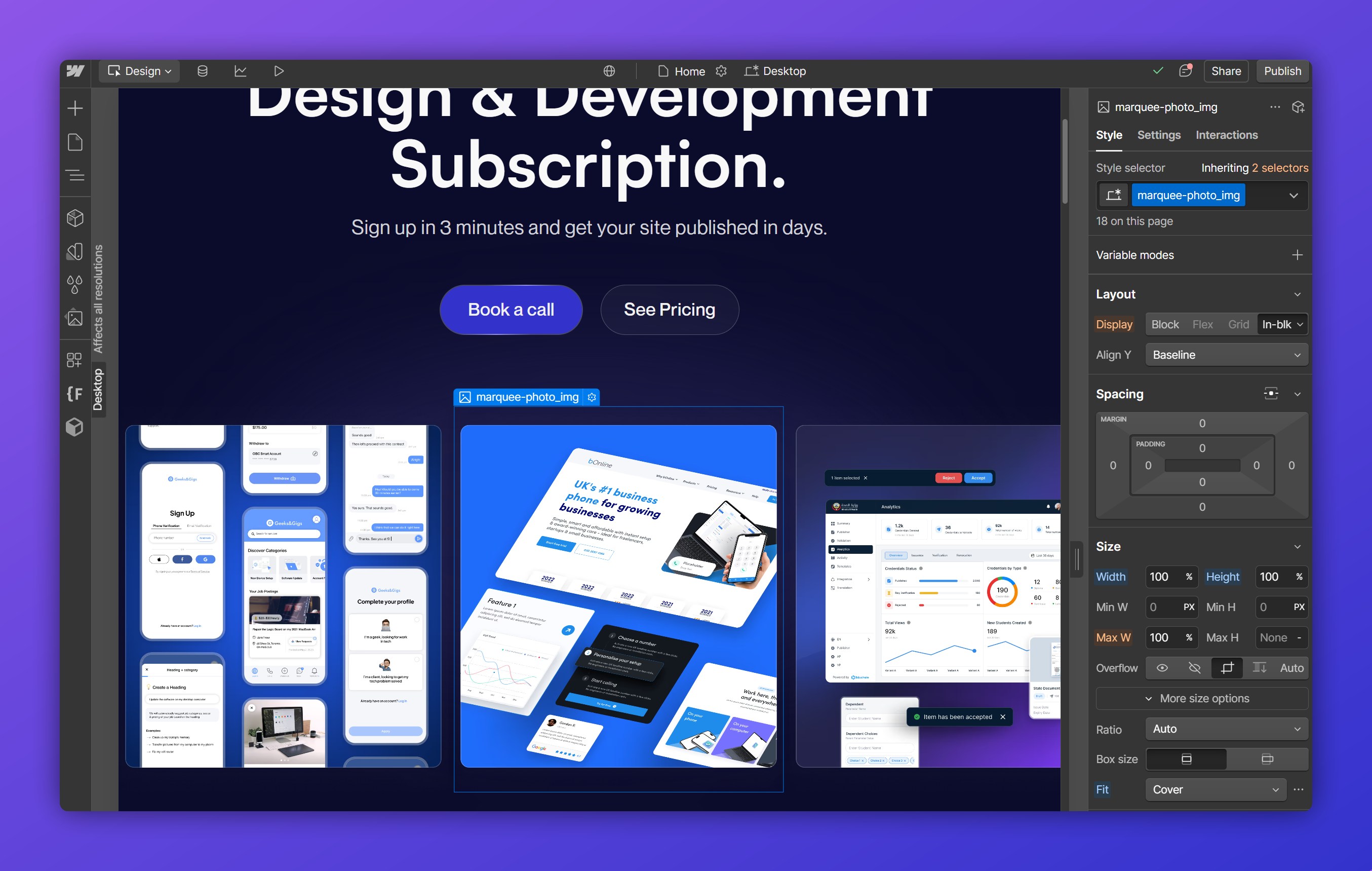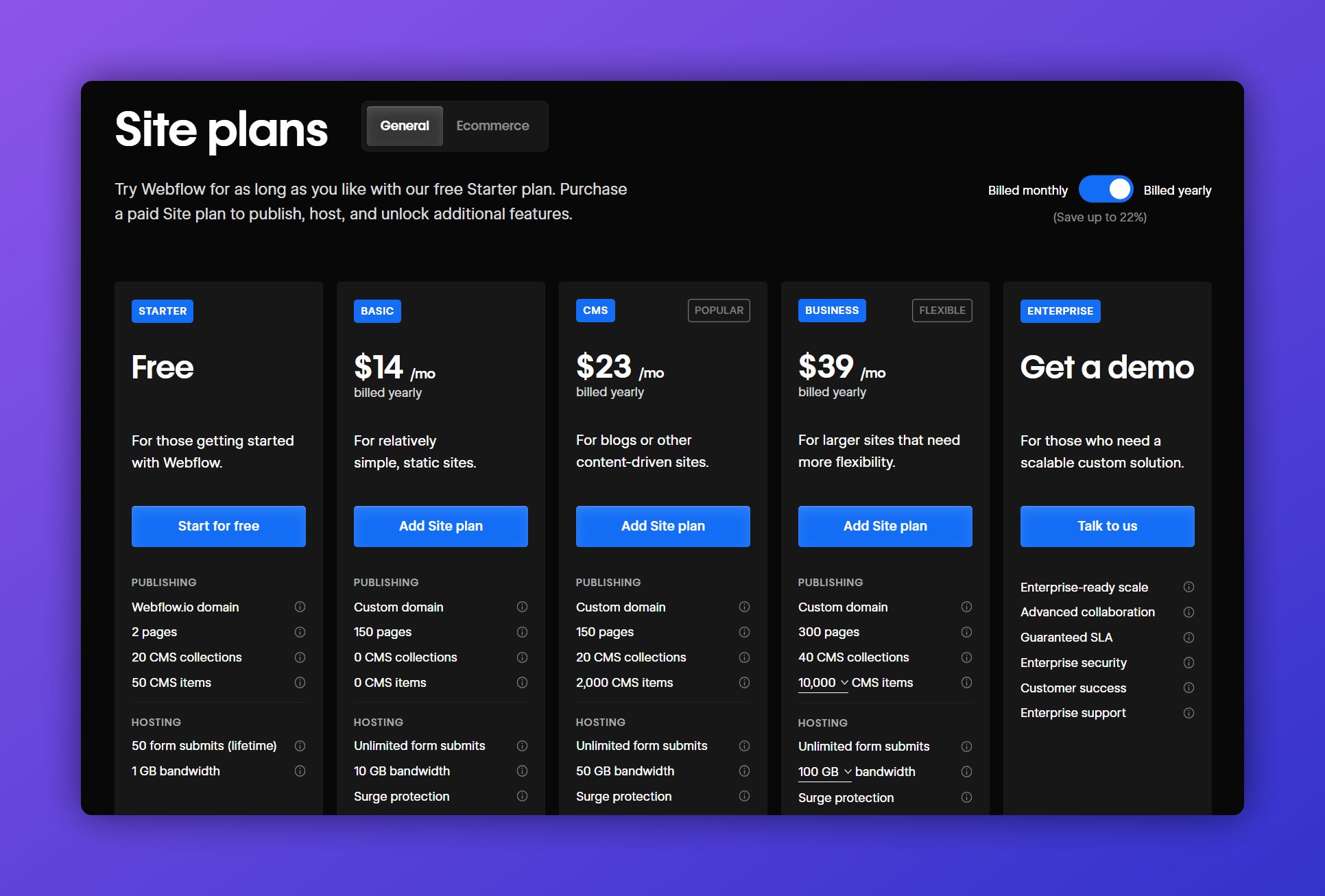TL;DR
Webflow and Squarespace are both robust website builders catering to different user needs.
Webflow offers advanced design flexibility and is ideal for those with web design experience seeking full creative control.
Squarespace provides user-friendly templates and is suitable for beginners or small business owners looking for an all-in-one solution.
Your choice should align with your design requirements, technical expertise, and business goals.
When it comes to building a website, choosing the right platform is crucial. Webflow and Squarespace are two of the most popular website builders, each offering a unique approach to web design. Whether you're a creative professional, a business owner, or a designer, the right platform depends on your specific needs. In this article, we'll compare Webflow and Squarespace across multiple factors to help you decide which is the best fit for your project.
Overview of Webflow

A Brief History of Webflow
Webflow was founded in 2013 with the goal of providing designers and developers with greater control over their web projects without requiring extensive coding. Over the years, it has evolved into a powerful platform that combines visual web design with CMS capabilities and hosting services.
Key Features of Webflow
- Design Flexibility: Webflow offers a highly customizable, code-free design interface, allowing users to create fully responsive and dynamic websites.
- CMS Integration: Users can build structured content collections, making it a great choice for blogs, portfolios, and business sites.
- E-Commerce Capabilities: Webflow includes features for online stores, including product catalogs, payment integration, and customizable checkout experiences.
- Hosting Services: Websites are hosted on Webflow’s fast and secure cloud-based infrastructure, ensuring reliable performance.
Who Should Use Webflow?
Webflow is ideal for designers, developers, and businesses looking for complete creative control over their websites. It’s best suited for users who are comfortable with a steeper learning curve in exchange for advanced customization options.
Overview of Squarespace

Background and Development
Squarespace was launched in 2003 as an all-in-one website builder that simplifies the web development process. It has become widely popular among creatives, entrepreneurs, and small business owners for its intuitive drag-and-drop interface and professional templates.
Key Features of Squarespace
- User-Friendly Templates: Squarespace offers beautifully designed, customizable templates that require no coding skills.
- Integrated Blogging and E-Commerce Tools: It provides built-in tools for content creation, product sales, and online payments.
- Hosting Services: All Squarespace websites are hosted on their secure and reliable infrastructure.
- SEO and Marketing Tools: The platform includes basic SEO optimization, email marketing, and social media integrations.
Who Should Use Squarespace?
Squarespace is perfect for small business owners, creatives, and individuals who need an easy-to-use platform to quickly launch a website without technical expertise. Using Squarespace? We have a great alternatives list if you are interested!
Feature Comparison
Customization and Design Freedom
Both Webflow and Squarespace offer visually appealing website-building capabilities, but they differ in their approach to customization.
Webflow
- Provides a fully flexible visual canvas for custom designs.
- Allows advanced styling, animations, and interactions.
- Best for users who want precise, custom-built layouts.
Squarespace
- Offers beautiful, professionally designed templates.
- Customization is limited to predefined layouts.
- Best for users who want an elegant design with minimal effort.
Choose Webflow if:
You want complete control over design and layout with advanced customization options.
Choose Squarespace if:
You prefer a polished, ready-made template that requires minimal tweaking.
Winner: Webflow for flexibility; Squarespace for ease of use.
Ease of Use and Learning Curve
The usability of a platform affects how quickly users can build and manage their websites.
Webflow
- Powerful but has a steeper learning curve.
- Requires some knowledge of design principles and structure.
- Supported by Webflow University, offering detailed tutorials.
Squarespace
- Beginner-friendly with a drag-and-drop interface.
- Simple setup process, making it ideal for non-technical users.
- Provides built-in tools that simplify website creation.
Choose Webflow if:
You're willing to learn a more advanced tool for greater design flexibility.
Choose Squarespace if:
You want an easy-to-use platform with minimal learning required.
Winner: Squarespace for beginners; Webflow for those willing to invest time in learning.
E-commerce Capabilities
For businesses looking to sell products online, e-commerce functionality is a key consideration.
Webflow
- Supports e-commerce with customizable product pages.
- Provides more design flexibility but fewer built-in e-commerce features.
- Best for visually stunning storefronts with unique designs.
Squarespace
- Built-in e-commerce tools with seamless product management.
- Offers features like abandoned cart recovery, subscriptions, and multi-channel selling.
- Best for users who want an all-in-one e-commerce solution.
Choose Webflow if:
You prioritize a custom-designed e-commerce store with full creative control.
Choose Squarespace if:
You want a straightforward e-commerce platform with built-in features.
Winner: Squarespace for convenience; Webflow for customization. But realistically neither of these, just use Shopify.
Pricing and Value
Cost plays a significant role in selecting the right platform.
Webflow
- Site plans start at $14 per month, while CMS plans begin at $23
- E-commerce plans start at $29 per month.
- Pricing scales based on usage, making it more expensive for larger or more successful projects.

Squarespace
- Pricing starts at $16 per month, with business plans at $23.
- E-commerce plans start at $27 per month.
- Offers an all-in-one package with hosting and domain registration included.

Choose Webflow if:
You need advanced design tools and are willing to pay for complete freedom and full website control.
Choose Squarespace if:
You want an affordable, all-inclusive solution with simple pricing.
Winner: Squarespace is not much more cheaper than Webflow, though Webflow charges just a bit more and gives you so much more power and flexibility.
SEO and Marketing Tools
Search engine optimization (SEO) and marketing features help drive traffic and grow an online presence.
Webflow
- Offers advanced SEO control, including clean code and custom schema markup.
- Allows detailed page structure optimization.
- Best for users with SEO knowledge who want full customization.

Squarespace
- Provides built-in SEO tools, including meta tags and social sharing options.
- Features automated SEO settings that require little user input.
- Best for users who want simple, effective SEO tools without manual configuration.
Choose Webflow if:
You need advanced SEO features and want complete control over your site’s optimization.
Choose Squarespace if:
You want easy-to-use SEO tools with minimal manual setup.
Winner: Webflow for advanced SEO; Squarespace for beginner-friendly SEO.
Scalability and Performance
As businesses grow, they need a platform that can scale with them.
Webflow
- Highly scalable with robust hosting through AWS.
- Ideal for dynamic, content-heavy sites with high traffic.
- Best for users who want a future-proof platform with room to grow.
Squarespace
- Suitable for small to medium-sized websites.
- Performance depends on Squarespace’s hosting infrastructure.
- Best for individuals and small businesses that don’t require enterprise-scale capabilities.
Choose Webflow if:
You need a scalable platform for a growing business or a complex project.
Choose Squarespace if:
You’re building a small to mid-sized website with predictable growth.
Winner: Webflow for scalability; Squarespace for simple projects.
Learning Resources and Community Support
Access to learning materials and community support helps users make the most of a platform.
Webflow
- Features Webflow University with detailed tutorials and courses.
- Active community with forums, meetups, and knowledge-sharing opportunities.
- Regular updates and continuous platform improvements.
Squarespace
- Provides built-in guides and a knowledge base for beginners.
- Offers customer support through live chat and email.
- Large community of users but fewer resources than Webflow.
Choose Webflow if:
You want an extensive library of learning materials and an active user community.
Choose Squarespace if:
You prefer a more straightforward support system with direct assistance.
Winner: Webflow for extensive learning resources; Squarespace for accessible customer support (though Webflow also has amazing customer support).
Webflow vs. Squarespace: Pros and Cons
Webflow: Best for Advanced Customization
Pros:
- Offers advanced design customization for complete creative freedom.
- Features a powerful CMS for managing structured content efficiently.
- Generates clean, developer-friendly code, ideal for performance and SEO.
- Provides scalable hosting with high-speed performance and security.
Cons:
- Steeper learning curve compared to beginner-friendly platforms.
- More complex pricing structure, which may require careful planning.
Squarespace: Best for Ease of Use and Simplicity
Pros:
- Features an easy-to-use, beginner-friendly interface for quick website creation.
- Offers professionally designed templates, great for creatives and businesses.
- Provides all-in-one hosting and domain management, reducing technical setup.
- Ideal for small businesses and personal websites with simple requirements.
Cons:
- Limited design flexibility compared to Webflow’s extensive customization options.
- Less control over SEO and site structure, impacting advanced optimization strategies.
Choosing the Right Platform
When to Choose Webflow
- You need complete creative control over design, interactions, and animations.
- You are a designer or developer comfortable with a steeper learning curve.
- Your project requires a scalable CMS to manage structured content efficiently.
When to Choose Squarespace
- You want a quick and simple way to build a professional-looking website.
- You’re a small business owner or creative looking for an all-in-one solution.
- Ease of use and minimal maintenance are your top priorities.
Final Thoughts
Webflow and Squarespace serve different audiences and project needs. Webflow is best suited for designers and developers who need advanced customization and CMS capabilities, while Squarespace is the ideal choice for users who prioritize ease of use and professionally designed templates. The right choice depends on your technical expertise, business goals, and long-term website strategy.
Need help planning, building or improving your website? Get a free consultation with our expert team!














